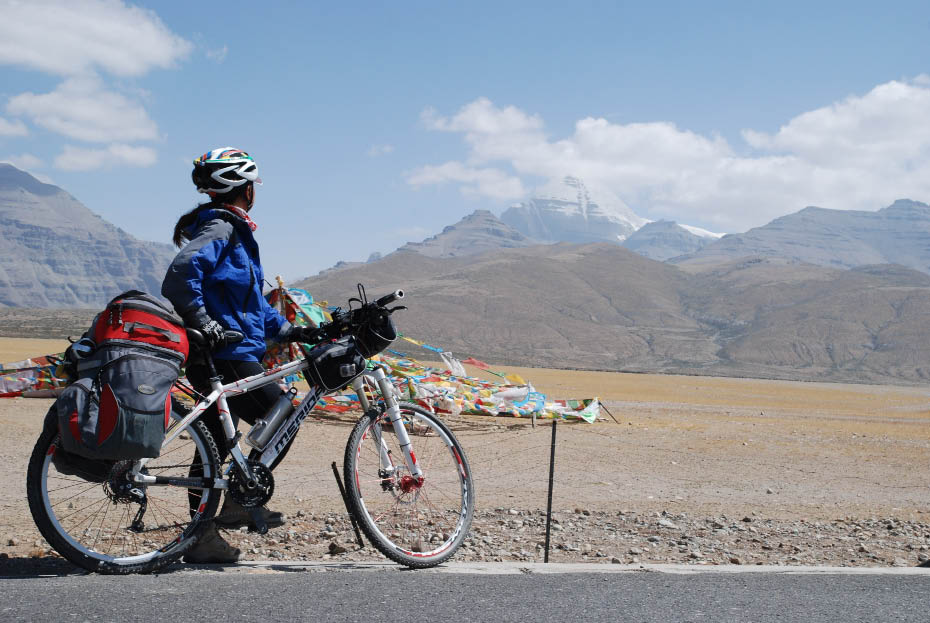Pedaling on the Horizon
Tibet to Xinjiang, by Bicycle
By ZHOU YANQIAO
 |
| Cycling buff Feiyun at the foot of Mt. Kangrinboqe. Zhou Yanqiao |
TO visit Tibet is a dream for all travelers who look for adventure. For those of us who like to seek out our adventures on foot or by bicycle, however, Tibet is a very bold dream indeed.
Walking or cycling up and across the plateau is either incredibly daring or incredibly foolish, depending on who you talk to. Exerting oneself at altitudes in excess of 5,000 meters can be dangerous; sleeping outside hundreds of miles from the nearest town – and at temperatures well below freezing – can be life threatening.
With full knowledge of the dangers, I decided to put myself to the test by riding across the Roof of the World last spring. My journey – close to 3,000 kilometers from the Tibetan capital, Lhasa, to Yecheng, just near Kashi City, in Xinjiang Uygur Autonomous Region – would take 39 days. It was, needless to say, quite a challenge, but it surely must rate as one of the world’s ultimate – and most stunning – endurance cycling routes.
Tibet is no stranger to me. I am a diehard cyclist, and have previously ridden the Sichuan-Tibet and Yunnan-Tibet routes. Both are punishing ordeals, but they pale in comparison to Tibet-Xinjiang. There’s also an attractive cultural element to this last route: it offers the rider the opportunity to explore Ngari, a prefecture in the far west of the plateau regarded as the cradle of Tibetan civilization.
Thin air, rough terrain and intimidating distances are a given when cycling on the plateau. But Tibet-Xinjiang features its own particular challenges: long sections of the ride sit at 5,100 meters above sea level, the 1,000-kilometer Gangdise Mountains cut straight across the route, and the ascent up and through the Kunlun range is incredibly steep. Added difficulties could arise from chance encounters with wild animals, some of which are predators.
I knew the journey would be worthwhile, though. If I had the guts to persevere, I’d be exposed to some of the most beautiful natural scenery on the planet.
Lhasa to Gyangze
I set off from Lhasa at the end of last April, and my two female teammates, Zhang Yuyun and Mao Lijuan, departed from Yecheng, Xinjiang, at the other end of our course. We estimated our paths would cross at Shiquanhe Town in Ngari, about 1,600 km from Lhasa.
As with my previous ventures in Tibet, I took a photo of myself with my bike in front of the gorgeous Potala Palace before heading for my first stop, Gyangze.
I rode 68 kilometers along smooth, paved roads before resting for the night. I met with my first challenge the very next day: crossing the 5,000-meter-high Kamba La Mountain. With baggage weighing in at 44 kg, I inched up the 35-km-long slope. Each push on the pedals was a strain. I was tempted to pull over and rest at some points, but I knew that once I stopped, it would be even harder to go on.
Vehicles whooshed past, their drivers craning their necks out the window to see the crazy man on the bicycle. They’d give me a thumbs up, cheer me on, and disappear up the road. After what seemed like an eternity I spotted prayer banners, signalling I’d reached the road’s highest point.
The banners led to Yamzhog Yumco, one of Tibet’s holiest lakes. The native Tibetan Bon religion was once widespread in the region, and its veneration of holy lakes and mountains was adopted into the syncretized Tibetan Buddhism that now dominates the plateau.
In the Bon tradition, Nam Co in Damxung, Mapam Yumco in Ngari and Yamzhog Yumco were said to be Tibet’s three holiest lakes, and are still regarded as such today.
For an exhausted traveler, the clear blue water of the serene Yamzhog Yumco is pure bliss. I’d worked hard to see the lake, and felt fully justified in pulling up to its shore for some quiet reflection. Such are the simple rewards that come with long-distance biking.
Yamzhog Yumco is in fact a small body of water. It’s encircled by peaks; in spring and summer the water’s surface lies unruffled by wind, and reflections of golden rape flowers on nearby hills, still against the aquamarine mirror, seem so real you could almost touch them.
Pilgrims often visit the shore, where they inevitably stack up piles of Mani stones: small pebbles inscribed with a six-syllable Buddhist mantra. They make wishes as they do this.
I spent the night in Nanggarze, the world’s highest county. The next day I rode across the Karuola Glacier, 5,100 meters above sea level. While I was slogging through the mountain pass, snow suddenly began to fall. The weather is erratic this high above sea level.

